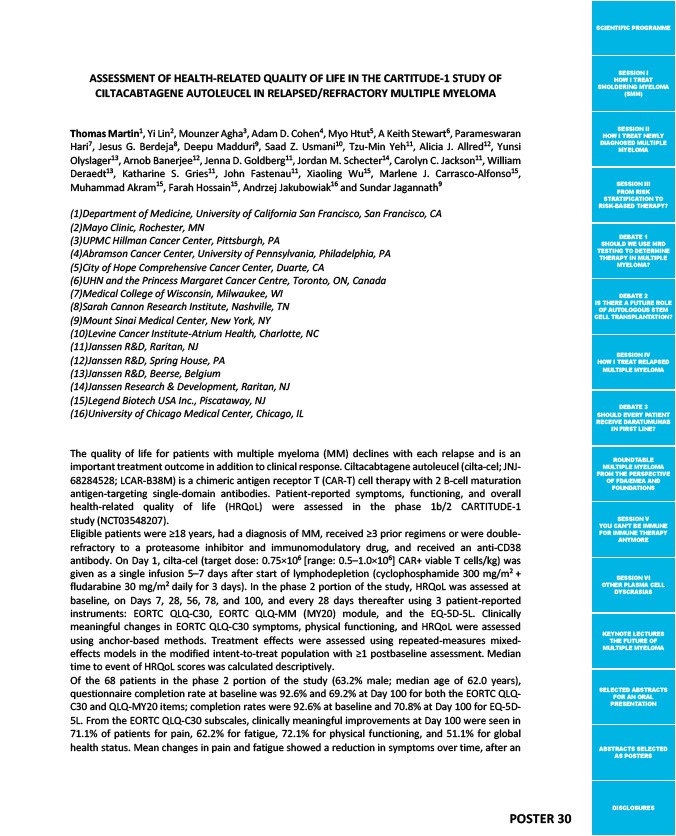
SCIENTIFIC PROGRAMME
SESSION I
HOW I TREAT
SMOLDERING MYELOMA
(SMM)
SESSION II
HOW I TREAT NEWLY
DIAGNOSED MULTIPLE
MYELOMA
SESSION III
FROM RISK
STRATIFICATION TO
RISK-BASED THERAPY?
DEBATE 1
SHOULD WE USE MRD
TESTING TO DETERMINE
THERAPY IN MULTIPLE
MYELOMA?
DEBATE 2
IS THERE A FUTURE ROLE
OF AUTOLOGOUS STEM
CELL TRANSPLANTATION?
SESSION IV
HOW I TREAT RELAPSED
MULTIPLE MYELOMA
DEBATE 3
SHOULD EVERY PATIENT
RECEIVE DARATUMUMAB
IN FIRST LINE?
ROUNDTABLE
MULTIPLE MYELOMA
FROM THE PERSPECTIVE
OF FDA/EMEA AND
FOUNDATIONS
SESSION V
YOU CAN’T BE IMMUNE
FOR IMMUNE THERAPY
ANYMORE
SESSION VI
OTHER PLASMA CELL
DYSCRASIAS
KEYNOTE LECTURES
THE FUTURE OF
MULTIPLE MYELOMA
SELECTED ABSTRACTS
FOR AN ORAL
PRESENTATION
ABSTRACTS SELECTED
AS POSTERS
DISCLOSURES
POSTER 30
ASSESSMENT OF HEALTH-RELATED QUALITY OF LIFE IN THE CARTITUDE-1 STUDY OF
CILTACABTAGENE AUTOLEUCEL IN RELAPSED/REFRACTORY MULTIPLE MYELOMA
Thomas Martin1, Yi Lin2, Mounzer Agha3, Adam D. Cohen4, Myo Htut5, A Keith Stewart6, Parameswaran
Hari7, Jesus G. Berdeja8, Deepu Madduri9, Saad Z. Usmani10, Tzu-Min Yeh11, Alicia J. Allred12, Yunsi
Olyslager13, Arnob Banerjee12, Jenna D. Goldberg11, Jordan M. Schecter14, Carolyn C. Jackson11, William
Deraedt13, Katharine S. Gries11, John Fastenau11, Xiaoling Wu15, Marlene J. Carrasco-Alfonso15,
Muhammad Akram15, Farah Hossain15, Andrzej Jakubowiak16 and Sundar Jagannath9
(1)Department of Medicine, University of California San Francisco, San Francisco, CA
(2)Mayo Clinic, Rochester, MN
(3)UPMC Hillman Cancer Center, Pittsburgh, PA
(4)Abramson Cancer Center, University of Pennsylvania, Philadelphia, PA
(5)City of Hope Comprehensive Cancer Center, Duarte, CA
(6)UHN and the Princess Margaret Cancer Centre, Toronto, ON, Canada
(7)Medical College of Wisconsin, Milwaukee, WI
(8)Sarah Cannon Research Institute, Nashville, TN
(9)Mount Sinai Medical Center, New York, NY
(10)Levine Cancer Institute-Atrium Health, Charlotte, NC
(11)Janssen R&D, Raritan, NJ
(12)Janssen R&D, Spring House, PA
(13)Janssen R&D, Beerse, Belgium
(14)Janssen Research & Development, Raritan, NJ
(15)Legend Biotech USA Inc., Piscataway, NJ
(16)University of Chicago Medical Center, Chicago, IL
The quality of life for patients with multiple myeloma (MM) declines with each relapse and is an
important treatment outcome in addition to clinical response. Ciltacabtagene autoleucel (cilta-cel; JNJ-
68284528; LCAR-B38M) is a chimeric antigen receptor T (CAR-T) cell therapy with 2 B-cell maturation
antigen-targeting single-domain antibodies. Patient-reported symptoms, functioning, and overall
health-related quality of life (HRQoL) were assessed in the phase 1b/2 CARTITUDE-1
study (NCT03548207).
Eligible patients were ≥18 years, had a diagnosis of MM, received ≥3 prior regimens or were double-refractory
to a proteasome inhibitor and immunomodulatory drug, and received an anti-CD38
antibody. On Day 1, cilta-cel (target dose: 0.75×106 range: 0.5–1.0×106 CAR+ viable T cells/kg) was
given as a single infusion 5–7 days after start of lymphodepletion (cyclophosphamide 300 mg/m2 +
fludarabine 30 mg/m2 daily for 3 days). In the phase 2 portion of the study, HRQoL was assessed at
baseline, on Days 7, 28, 56, 78, and 100, and every 28 days thereafter using 3 patient-reported
instruments: EORTC QLQ-C30, EORTC QLQ-MM (MY20) module, and the EQ-5D-5L. Clinically
meaningful changes in EORTC QLQ-C30 symptoms, physical functioning, and HRQoL were assessed
using anchor-based methods. Treatment effects were assessed using repeated-measures mixed-effects
models in the modified intent-to-treat population with ≥1 postbaseline assessment. Median
time to event of HRQoL scores was calculated descriptively.
Of the 68 patients in the phase 2 portion of the study (63.2% male; median age of 62.0 years),
questionnaire completion rate at baseline was 92.6% and 69.2% at Day 100 for both the EORTC QLQ-C30
and QLQ-MY20 items; completion rates were 92.6% at baseline and 70.8% at Day 100 for EQ-5D-
5L. From the EORTC QLQ-C30 subscales, clinically meaningful improvements at Day 100 were seen in
71.1% of patients for pain, 62.2% for fatigue, 72.1% for physical functioning, and 51.1% for global
health status. Mean changes in pain and fatigue showed a reduction in symptoms over time, after an